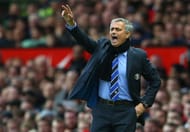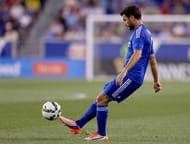Jose Mourinho’s Chelsea seems complete to the naked eye but something was lacking even throughout last season’s winning campaign and this is something that is an area where the Blues find themselves in quite a fix.
The missing piece. The last addition to a well oiled machine. A box to box goal scoring midfielder – another Frank Lampard.
The Predicament
One major dilemma for Chelsea is in central midfield. Against Arsenal at Wembley Mourinho opted to play Fabregas in the number 10 role with Ramires sitting deep behind him alongside Nemanja Matic - a tactic used sparingly last season, but one that Mourinho chooses when he is wary of the opposition’s creativity in midfield.
It is a tactic which lessens Chelsea’s control over the game and herein lies the problem. Fabregas can play satisfactorily when pushed up to number 10 but it’s not his strongest position, he is far more effective and dangerous when played in central midfield where he can influence the game to a greater extent.
However, he is suspect defensively and his lack of defensive nous is something that creates more pockets of space for the opposition and which leaves Nemanja Matic covering up more ground and having to work more strenuously in closing down his opponents.
When Fabregas plays number 10 – he doesn't get to dictate play, he doesn't see as much of the ball, he doesn't have the dribbling ability of a number 10 and he’s not the quickest – he’s a square peg in a round hole at number 10.
The stats don’t lie - when Fabregas was deployed as a number 10 and false nine for Barcelona he produced 14 assists making 1.6 key passes per game and averaged 60.7 passes a game, comparing that to his first season at Chelsea, the Spaniard produced 23 assists made 2.8 key passes per game and averaged 80.6 passes a game. There’s no doubt that number 10 is not his best position and it is in fact in central midfield.
Going back even further to his Arsenal days Fabregas’ best season was in 2009/10 (which also coincidently was when Arsenal played a 4-3-3 formation) with Fabregas playing in central midfield as part of the midfield three with Denilson/Song sitting. To no surprise he finished the season with 19 goals and 15 assists making 3.5 key passes per game, far better than the next season where Arsenal played a 4-1-3-2 and Fabregas was made to play number 10, subsequently causing his numbers to drop to 6 goals and 13 assists and 2.9 key passes.
This is the conundrum - Fabregas and his preferred position. He must play as an out and out central midfielder to exert optimum influence. However, his tackling is suspect.
According to WhoScored data, Fabregas attempted 196 tackles in the Premier League and Champions League being successful only with 103 with a success rate of 52% while Oscar has a tackle success rate of 59% and Nemanja Matic averages 63%. This is the issue, Fabregas can’t tackle as well as his team-mates.
Chelsea’s current midfield scenario
What usually happens is this. In bigger games, Mourinho anticipates the danger before the match and plays Ramires and Matic in the 2 slots of the 4-2-3-1 and shifts Fabregas to number 10. The game progresses and Chelsea are not able to dominate the ball.
Half time arrives and Mourinho brings on Oscar for Ramires, Fabregas shifts to occupy the slot Ramires was in and Chelsea start to dominate the ball and create more chances but it usually is too late and with the team attacking and Fabregas not being the best defensively, leaves the midfield more vulnerable to opposition attacks and Chelsea either concede or somehow manage to get bailed by some heroic saves or defending. It’s a recurring theme and something that must be addressed.
For this we have to look at the Chelsea formation – 4-2-3-1. Breaking it down to only the midfield triangle. The text book formation employs 2 defensive midfielders and one creative midfielder or out and out number 10. By playing Fabregas in the slot of a defensive midfielder or number 10 Chelsea upset the balance of player roles in the text book formation.
However, one midfield variant of the 4-2-3-1 is employing a deep lying playmaker instead of a defensive midfielder. Chelsea use this variant and it works well against smaller and mid table league opposition and Chelsea usually dominate the ball and win comfortably.
However, when Chelsea play the same system of a 4-2-3-1 against bigger opposition they find themselves wanting defensively and cannot dominate the ball. They usually concede more possession and their attacks are less frequent.
By playing Fabregas in that position, Chelsea become vulnerable to attacks when he ventures forward and find that area targeted by their opposition.
The Prime Example
Rewinding back to March, Chelsea were playing PSG in the Champions league round of 16 tie at Stamford Bridge and the Parisians started strongly with Marco Veratti pulling the strings, PSG were giving Chelsea a tough time and very little of the ball. Mourinho's men had just 35 percent of possession in the opening 15 minutes and dominated the game until Zlatan Ibrahimovic got sent off in the 31st minute for a lunge on Oscar while contesting a 50-50.
Chelsea were expected to take the game to their opponents and over-power a 10 man PSG side, however as the game wore on the blues found it difficult to dominate possession and got overrun in midfield by the trio of Thiago Motta, Marco Veratti and Blaise Matuidi who bossed the game despite being a man down and sprayed passes around Fabregas for fun while the midfielder haplessly played catch up.
A stark reminder of how the midfield battle wasn’t much of a battle was Fabregas gasping for air while trying to chase down Veratti and Matuidi on the right flank after losing the ball. PSG went on the create more chances and despite going ahead twice the blues managed to lose the tie.
Chelsea should have won that game especially given their numerical advantage and they should have had majority of possession yet they lost out in the center of the pitch with the final possession stats reading PSG 51% and Chelsea 49% once again highlighting the lack of another body to impose himself on the ball.
The Solution
Mind you this is a championship winning side and to suggest any alterations might seem preposterous, yet the only solution is that Chelsea will have to change their formation. Why would you change a Premier League winning side’s formation you ask? Well to operate more efficiently maximizing the type of players Chelsea have and to of course adapt – to provide an alternative if you will.
4-2-3-1 isn’t the best system given the roster Chelsea possess. It may work against lower and mid table opposition but not against a crowded opposition midfield especially against the likes Arsenal.
The solution – Inverting the pyramid into a flat out 4-3-3 with Matic holding and Fabregas and another central midfielder to partner him – a midfielder who can run box to box and score goals. Ramires is the only box to box midfielder currently in the squad and he may fit the bill, but Chelsea need somebody of more quality going forward, who can tackle, keep the ball and spray it around better than the Brazilian who isn’t known for his passing prowess.
4-3-3 is a system well known to Mourinho and Chelsea, it’s what won him back to back premier league titles in 2004 and 2005. It’s the system that the Blues played the most over the last decade and it worked marvelously well.
With a 4-3-3:
a) Chelsea will be able to have more of the ball, retain more possession and operate with more fluidity
b)Fabregas plays in his most suited position and can influence the game better
c) The burden on Matic is reduced with another player helping out defensively and closing down the spaces and
d) A narrower midfield can keep the ball better as there would be another body in the middle of the park to pass to with ease (instead of playing it through the opposition midfield up to Oscar at number 10.
Looking at the change in formation purely in terms of space –
a) Defensively, a 4-3-3 would tighten up the midfield making the midfielders more compact and harder to pass the ball through as compared to a 4-2-3-1 where the space between the number 10 and the two withdrawn players exists and can be exploited
b) Going forward there is more space for the two central midfielders to operate and drift into instead of the restricted space of playing a ball to a number 10
c) Lack of a number 10 frees an entire channel in the middle for wingers to cut inside to and for the centre forward to come deep and drag opposition defenders away.
Chelsea are in danger of losing the title because they might not adapt from last season. This way Chelsea can adapt and have a plan B - another play in the book for Mourinho. It’s something Mourinho could consider using to give the opposition something to think about rather than the expected 4-2-3-1 which teams expect him to field.
The Ideal Player
The answer is plain and simple. Chelsea haven’t replaced Frank Lampard. They brought in Fabregas, but after a season its quite apparent that the two are different players with different styles. Frank Lampard gave you 20 goals a season. Fabregas gives you 20 assists a season. Different players. Different qualities.
Chelsea lack goals from midfield in the way Frank Lampard so effortlessly scored for them. Oscar has performed decently enough but he is a number 10. Can he play in central midfield alongside Fabregas and Matic in a midfield three of a 4-3-3? It remains to be seen. He did have a good season last year scoring 7 and making 9 assists and the Brazilian does have a 59% tackle success rate, so theoretically he can be moulded into a quality central midfielder but certainly he lacks the build.
However, he has started in central midfield for the Brazilian national side. Oscar will have to considerably improve his all round game and increase his tally of goals to double digits at least to fill the void left by Lampard. Also if Mourinho does decide to stick to the same squad and field a 4-3-3, Oscar must be able to make the transition from number 10 and perform as an out and out central midfielder.
The other option would be to recruit a fresh player more adept at the role – Paul Pogba, Koke, Toni Kroos, Dani Parejo to name a few are players who would suit the system well but that’s the job of the scouting department at Stamford Bridge.
If the Blues can find the ideal candidate for the role it gives them the edge to adapt in big games like in the Champions league and will make the Chelsea machine operate at 100% efficiency instead of a mismatched 70% efficiency in terms of fluidity of player roles in the system.






